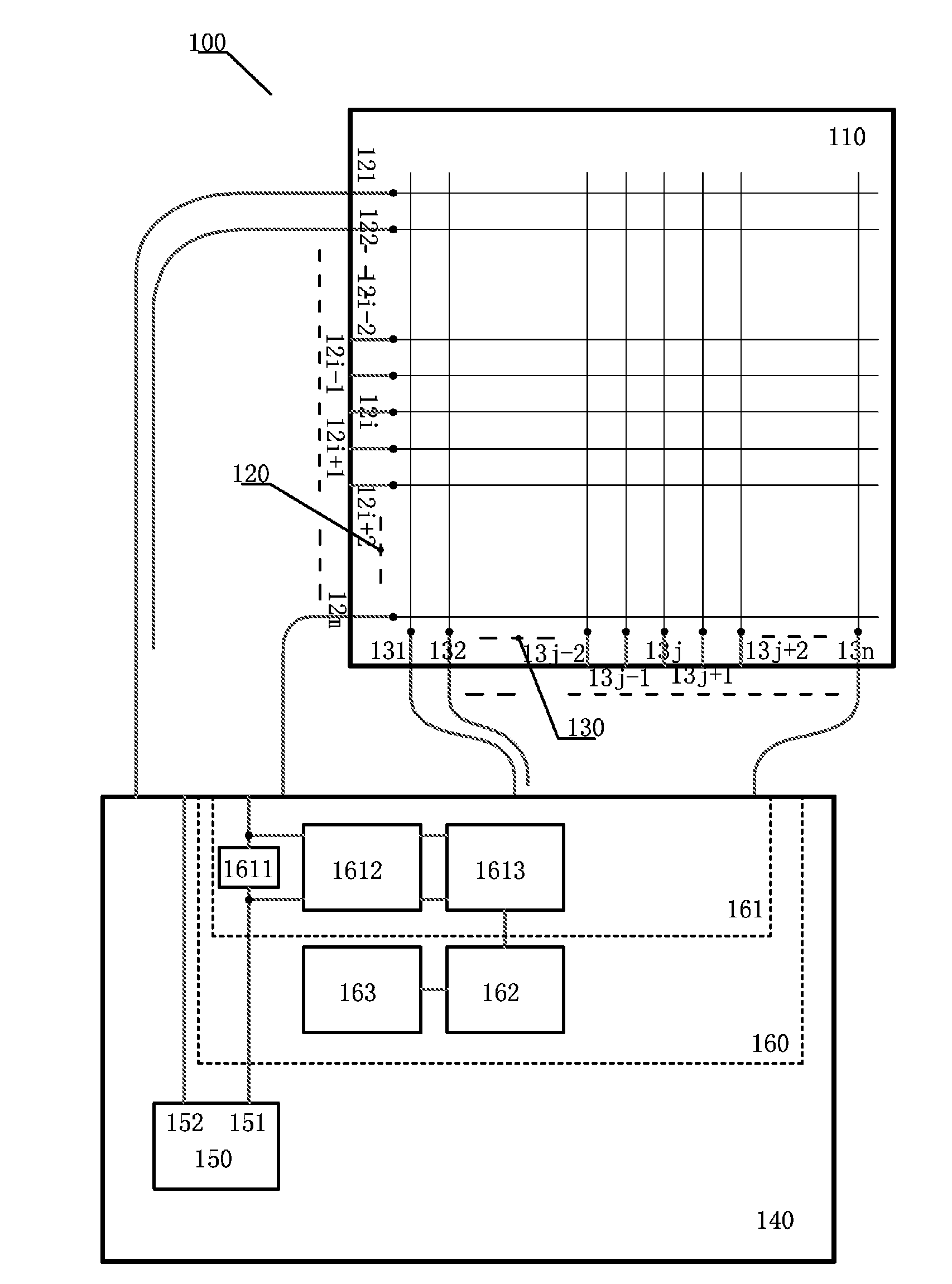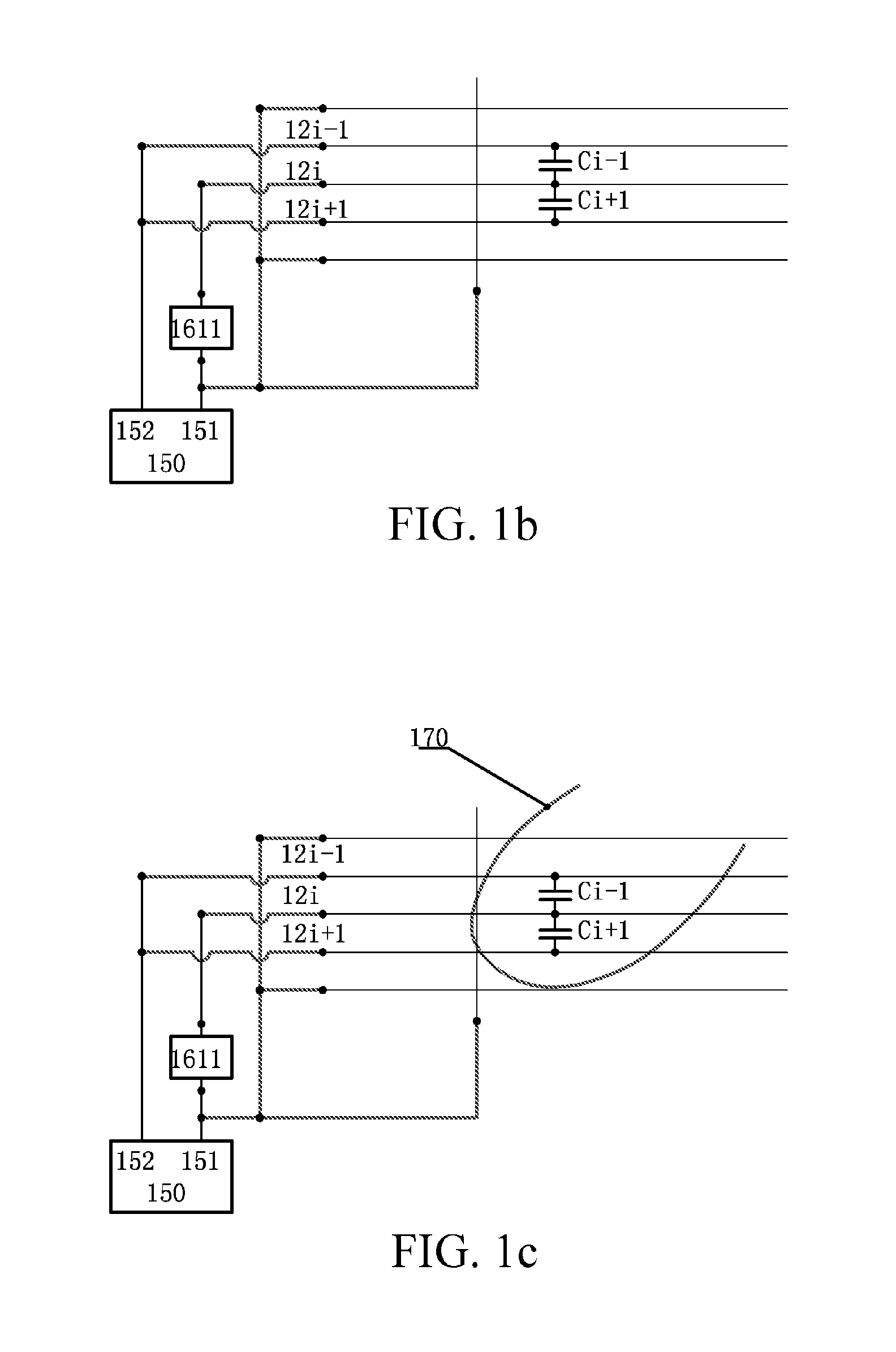Capacitive touch screen
a capacitive touch and touch screen technology, applied in the field of capacitive touch screen, can solve the problems of affecting and affecting the display quality, so as to reduce cross-talk, reduce cross-talk, and improve the accuracy of touching electrode determination
- Summary
- Abstract
- Description
- Claims
- Application Information
AI Technical Summary
Benefits of technology
Problems solved by technology
Method used
Image
Examples
second embodiment
[0067]The capacitive touch screen 100 as shown in FIG. 1a includes a touch panel 110 and a touch system circuit 140. A row electrode group 120 (including row electrode lines 121, 122, . . . , 12i−2, 12i−1, 12i, 12i+1, 12i+2, . . . , 12m) and a column electrode group 130 (including column electrode lines 131, 132, . . . , 13j−2, 13j−1, 13j, 13j+1, 13j+2, . . . , 13n) arranged orthogonal to each other are disposed on the touch panel 110 and isolated by an insulating layer. The touch system circuit 140 has a touch excitation source 150 and a touch signal detection unit 160. A touch signal frequency of the touch excitation source 150 is selected to be at least 100 KHz. The touch signal detection unit 160 is formed by a signal detection channel 161, a data convert channel 162, and a data processing and timing control unit 163. The signal detection channel 161 has a touch sampling element 1611, a buffer 1612, and a differential amplifier 1613. The data convert channel 162 has an ADC circu...
third embodiment
[0074]A product 200 where the capacitive touch screen is applied as shown in FIG. 2 includes a transparent touch panel 210, a touch system circuit 240, a display system, and a host circuit 280. A row electrode group 220 (including row electrode lines 221, 222, . . . , 22i−1, 22i, 22i+1, . . . , 22m) and a column electrode group 230 (including column electrode lines 231, 232, . . . , 23j−1, 23j, 23j+1, . . . , 23n) arranged orthogonal to each other are disposed on the touch panel 210 and isolated by an insulating layer. The touch system circuit 240 has a touch excitation source 250 and a touch signal detection unit 260. The touch excitation source 250 has output ends 251 and 252, and a touch signal frequency of the touch excitation source 250 is selected to be 100 KHz. The touch signal detection unit 260 is formed by a signal detection channel 261, a data convert channel 262, and a data processing and timing control unit 263. The signal detection channel 261 has a touch sampling elem...
fourth embodiment
[0079]A product 300 where the capacitive touch screen is applied as shown in FIG. 3 includes a transparent touch panel 310, a touch system circuit 340, a display system, and a host circuit 380. A row electrode group 320 (including row electrode lines 321, 322, . . . , 32i−1, 32i, 32i+1, . . . , 32m) and a column electrode group 330 (including column electrode lines 331, 332, . . . , 33j−1, 33j, 33j+1, . . . , 33n) arranged orthogonal to each other are disposed on the touch panel 310 and isolated by an insulating layer. The touch system circuit 340 has a touch excitation source 350 and a touch signal detection unit 360. The touch excitation source 350 has output ends 351 and 352, and a touch signal frequency of the touch excitation source 350 is selected to be 400 KHz. A gating-switch filter 353 for signals having a frequency of 400 KHz is disposed at the output end of the touch excitation source 350. The touch signal detection unit 360 is formed by a signal detection channel 361, a ...
PUM
 Login to View More
Login to View More Abstract
Description
Claims
Application Information
 Login to View More
Login to View More - R&D
- Intellectual Property
- Life Sciences
- Materials
- Tech Scout
- Unparalleled Data Quality
- Higher Quality Content
- 60% Fewer Hallucinations
Browse by: Latest US Patents, China's latest patents, Technical Efficacy Thesaurus, Application Domain, Technology Topic, Popular Technical Reports.
© 2025 PatSnap. All rights reserved.Legal|Privacy policy|Modern Slavery Act Transparency Statement|Sitemap|About US| Contact US: help@patsnap.com



